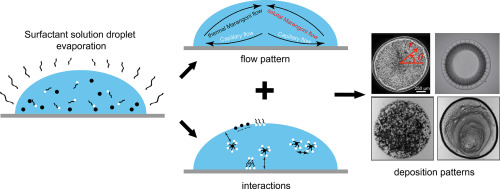当前位置:
X-MOL 学术
›
Adv. Colloid Interface Sci.
›
论文详情
Our official English website, www.x-mol.net, welcomes your feedback! (Note: you will need to create a separate account there.)
Role of surfactant in controlling the deposition pattern of a particle-laden droplet: Fundamentals and strategies.
Advances in Colloid and Interface Science ( IF 15.6 ) Pub Date : 2019-11-19 , DOI: 10.1016/j.cis.2019.102049 Xiaoxiao Shao 1 , Fei Duan 2 , Yu Hou 1 , Xin Zhong 1
Advances in Colloid and Interface Science ( IF 15.6 ) Pub Date : 2019-11-19 , DOI: 10.1016/j.cis.2019.102049 Xiaoxiao Shao 1 , Fei Duan 2 , Yu Hou 1 , Xin Zhong 1
Affiliation

|
Evaporation of particle-laden droplets has attracted wide attention propelled by the vast applications from disease diagnostics, bio-medicines, agriculture, inkjet printing to coating. Surfactant plays a vital role in controlling the deposition patterns of dried droplets, thanks to its extensive influences on particle transport through adsorbing at particle surface and droplet interfaces as well as suppressing or facilitating multiple flows. In order to accurately control the subtle morphology of a deposition, it is of significance to systematically elaborate the microscopic functions of surfactant, and bridge them to the various phenomena of a droplet. In this review, we first elucidate the effects of surfactant on the flow paradigms of capillary flow, solutal Marangoni flow, thermal Marangoni flow, and the mixed flow patterns as capillary force, thermal and solutal surface tensions are in competence or collaboration. Second, surfactant adsorption at particle surface and droplet interfaces modifying short-range and long-range forces such as electrostatic force, van der Waals force, capillary attraction, and hydrophobic bonding among particles and between particles and interfaces are introduced by the underlying mechanisms and approaches. Two phase diagrams are developed to respectively illustrate the roles of capillary force among particles, and the electrostatic interaction between particles and solid-liquid interface in modifying the deposition profiles. This review could build a fundamental framework of knowledge for evaporating particle-laden surfactant solution droplets, and may shed light on strategies to manipulate particle deposition in abundant fluidic-based techniques.
中文翻译:

表面活性剂在控制载有颗粒的液滴的沉积模式中的作用:基本原理和策略。
从疾病诊断,生物医学,农业,喷墨印刷到涂料的广泛应用推动了载有颗粒的液滴的蒸发,引起了广泛的关注。由于表面活性剂通过吸附在颗粒表面和液滴界面以及抑制或促进多重流动而对颗粒传输产生广泛的影响,因此在控制干燥液滴的沉积模式中起着至关重要的作用。为了精确地控制沉积物的细微形态,重要的是系统地阐述表面活性剂的微观功能,并将其与液滴的各种现象联系起来。在这篇综述中,我们首先阐明表面活性剂对毛细流,溶性马兰哥尼流,热马兰哥尼流以及混合流模式(毛细作用力)的流动范式的影响,热和溶液表面张力处于能力或协同作用中。其次,通过潜在的机理和方法介绍了表面活性剂在颗粒表面和液滴界面上的吸附,从而改变了短程和长程力,例如静电力,范德华力,毛细吸引力以及颗粒之间以及颗粒与界面之间的疏水键。开发了两个相图,分别说明了颗粒之间的毛细作用力,以及颗粒与固液界面之间的静电相互作用在改变沉积轮廓方面的作用。这篇综述可以为蒸发含颗粒的表面活性剂溶液液滴建立一个基本的知识框架,并且可以为在大量基于流体的技术中操纵颗粒沉积的策略提供启示。
更新日期:2019-11-19
中文翻译:

表面活性剂在控制载有颗粒的液滴的沉积模式中的作用:基本原理和策略。
从疾病诊断,生物医学,农业,喷墨印刷到涂料的广泛应用推动了载有颗粒的液滴的蒸发,引起了广泛的关注。由于表面活性剂通过吸附在颗粒表面和液滴界面以及抑制或促进多重流动而对颗粒传输产生广泛的影响,因此在控制干燥液滴的沉积模式中起着至关重要的作用。为了精确地控制沉积物的细微形态,重要的是系统地阐述表面活性剂的微观功能,并将其与液滴的各种现象联系起来。在这篇综述中,我们首先阐明表面活性剂对毛细流,溶性马兰哥尼流,热马兰哥尼流以及混合流模式(毛细作用力)的流动范式的影响,热和溶液表面张力处于能力或协同作用中。其次,通过潜在的机理和方法介绍了表面活性剂在颗粒表面和液滴界面上的吸附,从而改变了短程和长程力,例如静电力,范德华力,毛细吸引力以及颗粒之间以及颗粒与界面之间的疏水键。开发了两个相图,分别说明了颗粒之间的毛细作用力,以及颗粒与固液界面之间的静电相互作用在改变沉积轮廓方面的作用。这篇综述可以为蒸发含颗粒的表面活性剂溶液液滴建立一个基本的知识框架,并且可以为在大量基于流体的技术中操纵颗粒沉积的策略提供启示。


























 京公网安备 11010802027423号
京公网安备 11010802027423号